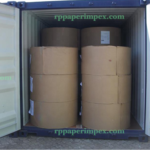What is the Process Followed While Paper Manufacturing
What is the Process Followed While Paper Manufacturing
What is the Process Followed While Paper Manufacturing – Paper stands for thin sheets often produced from cellulose pulp derived from wood. In the year 2021 round about 96 million metric tons of graphic paper were manufactured worldwide. Meanwhile, board and packaging paper production amounted to 264 million metric tons. Overall, the quantity of paper and paperboard produced worldwide in 2021 weighed more than 417 million metric tons. The global pulp and paper industry is projected to grow rapidly from $354.39 billion in 2022 to $372.70 billion by 2029, at a CAGR of 0.72% in the forecast period 2022-2029. The largest industry is forest-based.
Due to rising requirements for printing, labeling, packaging, and writing paper products, the global paper production capacity is projected to reach 510 million tons by 2025. The paper manufacturing process is a resource-intensive and complicated procedure, it includes recycled paper, wood paper, or other plant-based fibers. Paper is a versatile material that is used for various applications such as printing, packaging, personal care, promotional materials, and much more. Here in this blog, we explain What is the Process Followed While Paper Manufacturing.
What is Paper Manufacturing?
Converting raw material into the best paper is called the paper manufacturing process the cycle involves several stages like pulping, refining, screening, and drying, each of which plays an important role in determining the quality and properties of the final result. Process Followed Paper Manufacturing depends on the type of paper being produced, raw materials, and the specific manufacturing cycle.
Basics Steps of Paper Manufacturing: How Paper is Made?
Today the paper industry adopting technology to improve the efficiency and sustainability of manufacturing procedures such as best energy consumption and reducing water. Here are the basic steps of producing paper:
Preparation of the Paper
The preparation of raw materials is the first step of Paper Manufacturing. It begins to break down the raw material (wood pulp to softwood), typically wood chips, into small fibers that can be used to make paper. The raw material is transported to paper mills and logs undergo debarking. After this chipped the material into small pieces.
- Selection of trees
- Collection of recycled paper
- Cotton
- Bamboo and other alternative fibers
Pulping
Without pulping you can not proceed with your paper manufacturing process. In this crucial step, wood is broken down into wood chips, and recycled paper or other raw materials are turned into pulp, which is then used to make paper. Here are the methods of pulping.
| Mechanical Pulping | Chemical Pulping |
| Stone Groundwood (SGW) Process | Kraft Process |
| Refiner Mechanical Pulp (RMP) Process | Sulfite Process |
Cleaning and Screening
Cleaning and screening are crucial steps in the paper manufacturing process. After pulping the resulting pulp contains not only fibers but also dust, bark, and other debris. Cleaning and screening help to decrease this impurity.
| Cleaning | Screening |
| Centrifugal cleaning | Removal of oversized materials |
| Flotation cleaning | Separation of fiber lengths |
| Screening | Pulp fractions |
Refining
Refining occurs after the cleaning and screening procedure. The main target of refining is to improve the properties and quality of the pulp fibers. This paper manufacturing mechanically treats the pulp to alter the fiber structure, leading to enhanced bonding and strength characteristics. Refining is particularly vital for producing superior-quality papers that are widely used in printing, writing, or specialty applications.
| Refining Techniques | Effects of Refining |
| Conical Refiners | Fiber Fibrillation |
| Double Disc Refiners | Increased Surface Area |
| Jordan Engine | Improved Sheet Formation |
Paper Formation
In the formation stage, the raw paper is diluted with water to make a slurry and then this slurry forms into sheets using paper machines. Typically the machines consist of forming sections, drying sections, and press sections.
- Headbox
- Forming Fabrics
- Forming Fabric
- Forming fabric
- Couch Roll
- Press Section
- Calendering
- Reeling
Pressing
In the next basic step of the paper manufacturing process, the formed sheets pass through the press section. It helps to remove excess water from wet paper, raising its dryness and strength before it enters the drying section. The paper is pressed between rollers to eliminate water and consolidate the fibers.
- Transfer from Fourdrinier Section
- Felt and Press Rolls
- Pressing Action
- Water Removal
- Felt Conditioning
- Improved Dryness and Strength
Drying
Dring is a fundamental Process Followed While Paper Manufacturing. Now the sheets enter in drying section where the remaining moisture is well evaporated. This stage plays a crucial role in providing the final product.
- Drying cylinders
- Steam and heat transfer
- Dryness measurement
- Size press
Calendaring
Calendaring is a finishing process in the paper manufacturing industry that goes along with the drying stage. It involves passing the dried paper sheet through a series of calendar rolls and applying pressure and heat to improve its surface characteristics. It helps to improve the quality of the paper’s smoothness, gloss, and overall appearance.
- Improve surface finishing
- Enhance prinitibality
- Control Caliper
- Increase Gloss
Reeling
Reeling is the final Process Followed While Paper Manufacturing. The finished paper is represented as a called parent rolls or reels. This step occurs after the paper has undergone various processes, including forming, refining, pressing, cleaning, screening, drying, and calendaring.
- Trimming
- Relling machine
- Splicing
- Transportation and storage





